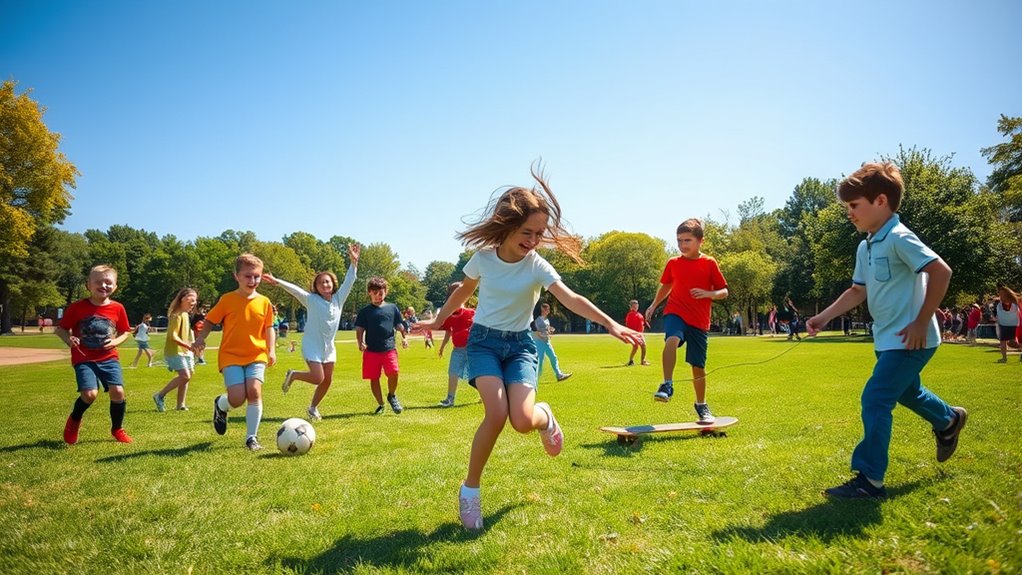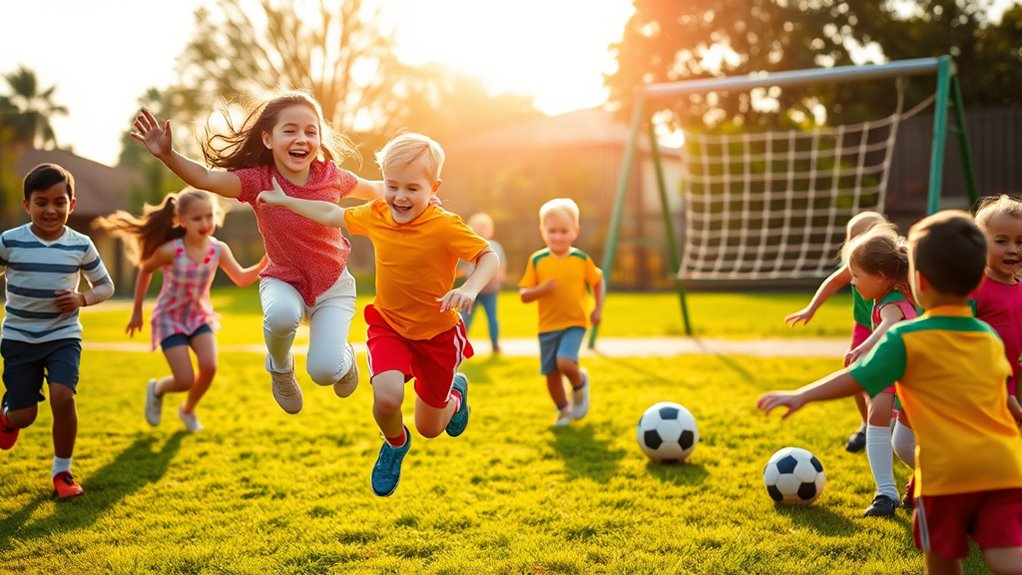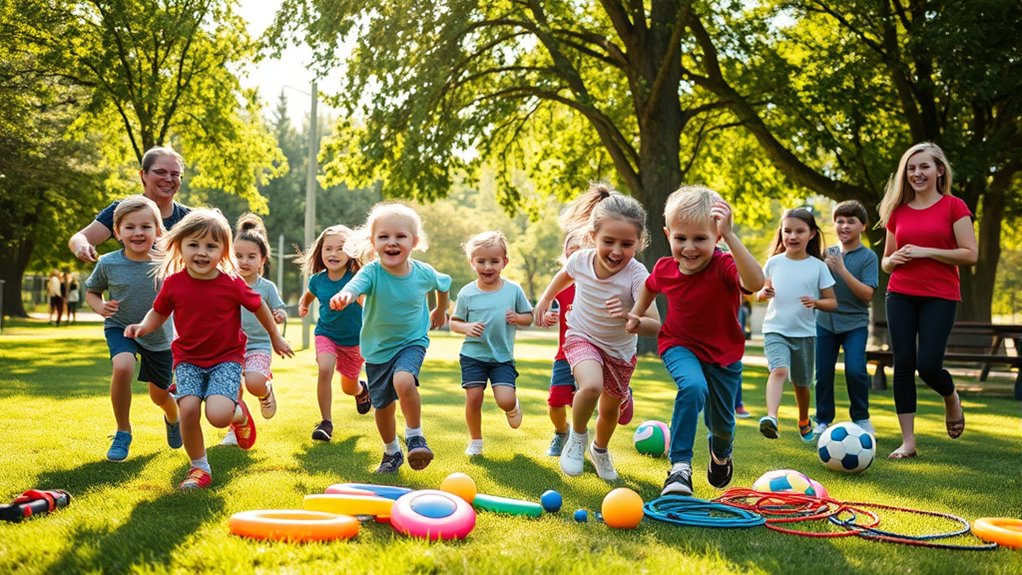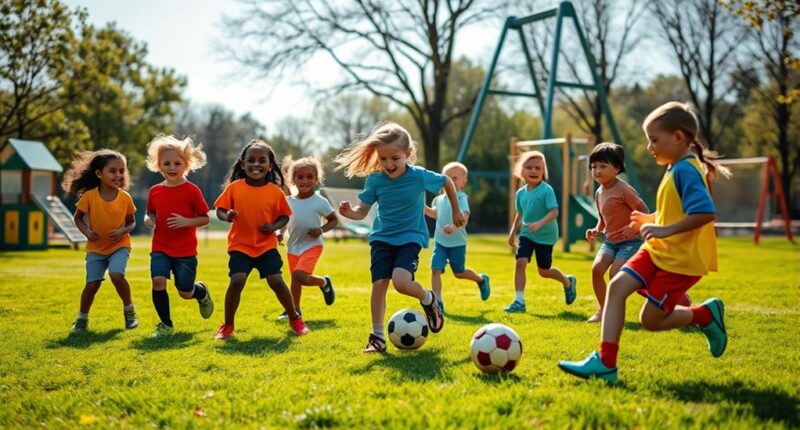Encouraging physical activity through sports and games is essential for your child’s growth. It boosts their physical health, enhances coordination, and builds strong bones and muscles. Engaging in team sports fosters social skills and promotes emotional regulation. However, barriers like safety concerns and limited space might hinder their play. By incorporating fun, achievable activities into their routine, you can inspire a more active lifestyle. Discover more tips and strategies to help them stay active and thrive.
Key Takeaways
- Introduce team sports to foster cooperation, teamwork, and social skills among children, enhancing their overall development.
- Plan regular, fun activities that align with children’s interests to build confidence and encourage consistent participation.
- Limit screen time to promote outdoor play, exploration, and imaginative games that stimulate creativity and physical fitness.
- Engage the whole family in active pursuits to model a healthy lifestyle and strengthen family bonds while encouraging exercise.
- Utilize community resources like local playgrounds and programs to create a supportive environment that promotes active living for children.
The Benefits of Physical Activity for Children

When you encourage your child to engage in physical activity, you’re not just promoting fun; you’re also supporting their overall health and development.
Regular physical activity helps your child grow strong bones and muscles while maintaining a healthy weight, reducing obesity risk. It boosts cardiovascular fitness, lowers the chances of chronic diseases, and enhances coordination and balance. Additionally, active children are less likely to be obese compared to inactive peers. Engaging in sports also teaches children to establish clear boundaries with peers, fostering important social skills. Furthermore, participating in regular physical activity can help children develop essential life skills such as goal-setting and resilience. Additionally, exercise is linked to improved mental well-being, which can help children manage stress and anxiety more effectively. Engaging in physical activity can also enhance cognitive function, leading to better focus and memory retention, which benefits academic performance. Moreover, engaging with educational toys that promote physical activity can further support their development in a fun and engaging way.
Encouraging regular physical activity promotes strong bones, healthy weight, and boosts overall fitness while reducing chronic disease risk.
Beyond physical health, exercise plays an important role in mental well-being, reducing anxiety and depression while increasing self-esteem and mood through endorphins.
It also aids cognitive development, improving focus and memory, which can boost academic performance.
Finally, physical activity fosters social skills, teamwork, and essential life skills, giving your child a well-rounded foundation for their future.
The Importance of Sports in Child Development

Sports play an essential role in child development, offering more than just physical benefits. Through regular activity, you enhance motor skills, coordination, and overall fitness, reducing the risk of obesity and fostering healthy habits. You also build strength, endurance, and flexibility, crucial for lifelong well-being. Additionally, participation in sports fosters teamwork and cooperation, which is vital for developing social skills among peers. Furthermore, engaging in sports promotes emotional regulation, helping children manage their feelings and responses during both competition and play. Regular participation in sports can also improve mental health by reducing anxiety and enhancing mood. Moreover, parents who actively support their children’s involvement in sports can contribute to their overall well-being, ensuring they feel loved and encouraged. Furthermore, a strong focus on continuous learning in sports can help children develop a growth mindset, essential for overcoming challenges in various aspects of life. Engaging in sports also encourages environmental interactions, which are crucial for holistic development and understanding social dynamics.
On the social front, sports teach you teamwork, cooperation, and communication, helping you forge strong peer relationships and a sense of belonging. Emotionally, sports boost your self-esteem and resilience, equipping you to handle both successes and failures.
Additionally, engaging in sports enhances academic performance through improved focus and discipline. By participating in sports, you develop important life skills like leadership, decision-making, and perseverance, setting the foundation for personal growth and character development.
Overcoming Barriers to Physical Activity

Despite the numerous benefits of physical activity, many kids face barriers that can hinder their participation. Parental restrictions due to safety concerns or time constraints can limit opportunities for play. You might also struggle with a lack of time and space at home or school, making it hard to stay active. Schools are identified as key settings for promoting physical activity and reducing sedentary behavior, highlighting the potential for improvement in this area. Additionally, the importance of long-term planning for physical activities can help families overcome these barriers and ensure consistent participation. Regular engagement in health and wellness benefits from physical activity can also motivate kids to stay active. Creating a supportive environment for play can enhance home and heritage connections, fostering a sense of belonging. Implementing community events that encourage active participation can significantly boost kids’ engagement in physical activities. Furthermore, awareness of local store hours can assist families in planning outings that incorporate physical activity.
Screen time can easily replace outdoor activities, leading to more sedentary habits. If you worry about your physical ability or fear getting injured, it can be tough to join in on sports. Environmental factors, like bad weather or limited access to safe spaces, add to the challenge. Recognizing these barriers is the first step toward finding ways to encourage more active lifestyles.
Strategies to Promote Active Lifestyles

To encourage kids to lead active lifestyles, it’s important to implement effective strategies that make physical activity enjoyable and accessible.
Start by incorporating games and challenges that align with your child’s interests, ensuring they find joy in movement. Plan regular activities that are challenging yet achievable to build confidence. Role modeling and family participation can enhance their motivation to stay active. Additionally, consider introducing team sports that promote collaboration and social interaction among peers. Engaging in group activities can also foster a sense of community and support among children.
Variety is key, so offer different options suitable for all abilities. Create a daily routine that includes physical activity, and set aside time for active family outings like hiking or biking.
Limit screen time to promote outdoor play and exploration. Finally, be a role model by engaging in physical activities yourself. Your enthusiasm will inspire them to embrace an active lifestyle.
The Role of Community and Family in Encouraging Exercise

When communities and families work together to encourage exercise, children are more likely to develop healthy habits that last a lifetime. Access to safe playgrounds, schools, and community centers equipped with programs like those offered by the YMCA or Boys and Girls Clubs creates ample opportunities for physical activity. Consistent messaging about the fun of physical activity is essential in making these opportunities appealing to children. Engaging in family-friendly activities such as sports can provide a wonderful bonding experience while promoting fitness. Your involvement as a parent makes a significant difference; kids with active parents are more inclined to join sports and enjoy family activities. Reinforcing the value of exercise at home and limiting sedentary behaviors sets a positive example. Additionally, creating organized environments can help reduce distractions and encourage family members to participate in physical activities together. Research shows that active kids are more likely to maintain a healthy weight and develop strong social skills. Plus, friendships and social circles play an essential role—active peers motivate kids to participate. Sustainable living practices can also extend to encouraging exercise, emphasizing the importance of community resources and family support that foster an environment where children thrive physically and socially. Engaging in imaginative play through activities like sports can also enhance children’s problem-solving skills, contributing to their overall development. Together, community resources and family support foster an environment where children thrive physically and socially.
Frequently Asked Questions
What Types of Sports Are Best for Different Age Groups?
When considering what types of sports are best for different age groups, think about their developmental needs.
For young children, activities like running and swimming build motor skills and coordination.
As they reach elementary school, soccer and gymnastics enhance teamwork and flexibility.
Pre-teens can thrive in football or basketball, which require strategy and agility.
Finally, teens can benefit from both individual sports, like swimming, and team sports, such as volleyball, to foster fitness and collaboration.
How Can I Measure My Child’s Physical Activity Levels?
Imagine you’re a gardener, nurturing a young plant. To measure its growth, you check the soil, sunlight, and water.
Similarly, you can assess your child’s physical activity. Use accelerometers or pedometers to track steps, or heart rate monitors to gauge intensity. GPS devices reveal distances covered during outdoor adventures, while observational methods let you see their engagement in play.
Apps can make tracking fun, turning exercise into a game of growth and exploration.
Are There Any Specific Sports for Children With Disabilities?
Yes, there are several sports specifically designed for children with disabilities.
You might explore adaptive sports like wheelchair basketball, sled hockey, or therapeutic riding.
Programs like the Miracle League offer baseball on accessible fields, while organizations like the Special Olympics provide various competitive opportunities.
These sports not only enhance physical skills but also promote social interaction, self-esteem, and a sense of belonging, ensuring every child can participate and thrive in a supportive environment.
How Do I Choose the Right Sports Equipment for My Child?
When choosing the right sports equipment for your child, start by selecting items specific to the sport they’re interested in.
Make sure the gear fits properly and meets safety standards to prevent injuries. Invest in quality, age-appropriate equipment that supports their growth and performance.
Prioritize comfort and breathability in clothing and footwear.
Don’t forget to take into account hydration options and healthy snacks to keep them energized and focused during activities.
What Are Fun Games to Play That Encourage Physical Activity at Home?
You can have a blast at home with fun games that get everyone moving!
Try indoor balloon tennis, where you use balloons and fly swatters, or set up an obstacle course using cushions and chairs.
For a creative twist, make a fitness bingo with different exercises to complete.
Don’t forget classic games like indoor hopscotch or DIY Olympics to spark some friendly competition.
These activities will keep you active and entertained!
Conclusion
Incorporating sports and games into your child’s routine can have a lasting impact on their health and development. Did you know that kids who regularly engage in physical activity are 40% more likely to perform better academically? By prioritizing exercise, you’re not just boosting their physical fitness; you’re also enhancing their cognitive abilities. So, let’s work together as a community and family to create an environment that encourages active lifestyles and fosters a love for movement in our children.









